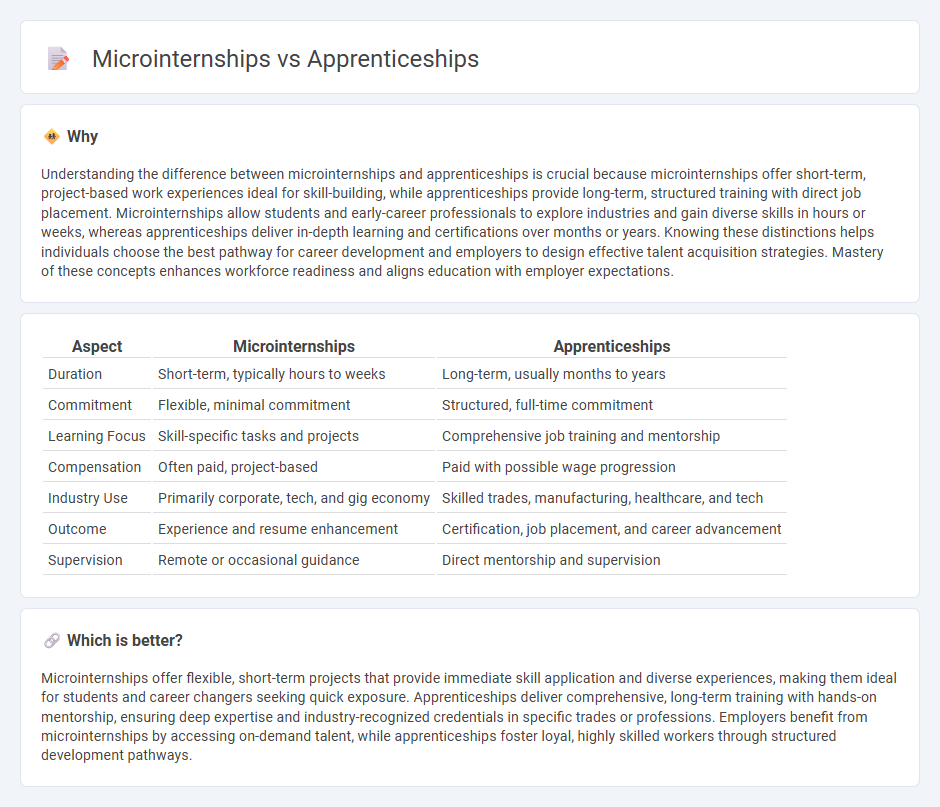
Microinternships offer short-term, project-based work experiences that allow students and recent graduates to develop specific skills quickly, often completed remotely and flexibly. Apprenticeships provide long-term, structured training programs combining on-the-job experience with classroom instruction to build comprehensive expertise in a trade or profession. Explore the key differences and benefits of microinternships and apprenticeships to determine the best fit for your career goals.
Why it is important
Understanding the difference between microinternships and apprenticeships is crucial because microinternships offer short-term, project-based work experiences ideal for skill-building, while apprenticeships provide long-term, structured training with direct job placement. Microinternships allow students and early-career professionals to explore industries and gain diverse skills in hours or weeks, whereas apprenticeships deliver in-depth learning and certifications over months or years. Knowing these distinctions helps individuals choose the best pathway for career development and employers to design effective talent acquisition strategies. Mastery of these concepts enhances workforce readiness and aligns education with employer expectations.
Comparison Table
| Aspect | Microinternships | Apprenticeships |
|---|---|---|
| Duration | Short-term, typically hours to weeks | Long-term, usually months to years |
| Commitment | Flexible, minimal commitment | Structured, full-time commitment |
| Learning Focus | Skill-specific tasks and projects | Comprehensive job training and mentorship |
| Compensation | Often paid, project-based | Paid with possible wage progression |
| Industry Use | Primarily corporate, tech, and gig economy | Skilled trades, manufacturing, healthcare, and tech |
| Outcome | Experience and resume enhancement | Certification, job placement, and career advancement |
| Supervision | Remote or occasional guidance | Direct mentorship and supervision |
Which is better?
Microinternships offer flexible, short-term projects that provide immediate skill application and diverse experiences, making them ideal for students and career changers seeking quick exposure. Apprenticeships deliver comprehensive, long-term training with hands-on mentorship, ensuring deep expertise and industry-recognized credentials in specific trades or professions. Employers benefit from microinternships by accessing on-demand talent, while apprenticeships foster loyal, highly skilled workers through structured development pathways.
Connection
Microinternships and apprenticeships both offer hands-on work experience that accelerates skill development and enhances employability. These work-based learning opportunities emphasize real-world projects and mentorship, providing practical exposure that bridges academic knowledge with industry requirements. By integrating short-term, project-focused microinternships and longer-term, structured apprenticeships, organizations can cultivate talent pipelines more effectively.
Key Terms
Duration
Apprenticeships typically span several months to years, offering in-depth, hands-on training within a specific industry or trade, while microinternships last a few days to weeks, providing short-term project-based work experiences. The extended duration of apprenticeships allows for comprehensive skill development and potential job placement, whereas microinternships emphasize flexibility and rapid exposure to real-world tasks. Explore the key differences to determine which experiential learning opportunity aligns best with your career goals.
Skill Development
Apprenticeships offer structured, long-term training with hands-on experience in a specific trade or profession, fostering deep skill development and mastery. Microinternships provide short-term, project-based tasks that allow individuals to gain exposure and build diverse skills quickly across various industries. Explore more to understand which option best suits your career growth and skill-building goals.
Commitment
Apprenticeships require a long-term commitment, often spanning months or years, providing extensive hands-on training and skill development in a specific trade or profession. Microinternships offer short-term, project-based experiences that typically last a few days to weeks, allowing flexibility and exposure without the deep time investment. Explore more about how commitment levels impact career growth in these experiential learning models.
Source and External Links
Career Seekers - Apprenticeship.gov - Apprenticeships are industry-driven, paid on-the-job training programs where individuals earn wages, gain classroom instruction, and earn nationally recognized credentials to start a career quickly in high-demand fields.
Apprenticeship.gov: Homepage - Apprenticeship.gov connects career seekers and employers with apprenticeship resources, offering paid learning, national credentials, and an average starting salary after completion of $80K with strong employment retention rates.
Find an apprenticeship - GOV.UK - In England, apprenticeships allow individuals aged 16 or over to work, get paid, and train to gain qualifications, with no upper age limit and open to those with prior education qualifications.
 dowidth.com
dowidth.com